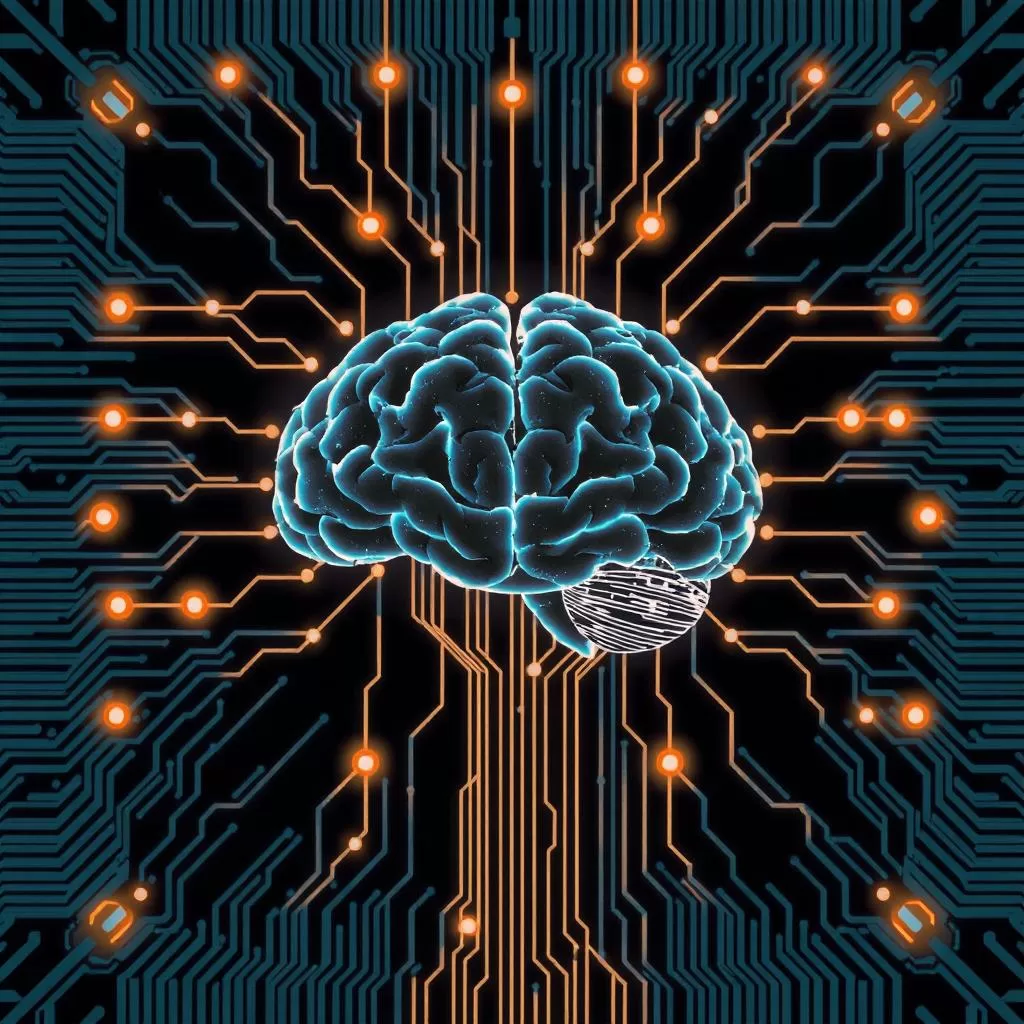Brain-Computer Interfaces (BCI):Human-AI Integration
What if you could control your phone, type messages, or even play video games—just by thinking? Brain-computer interfaces (BCI) are making this futuristic vision a reality, enabling direct communication between the human brain and digital devices.
With companies like Neuralink, Meta, and OpenBCI investing in BCI technology, it won’t be long before we see AI-powered brain implants enhancing human capabilities. But how does BCI work, and what are its real-world applications?
What You’ll Learn in This Article:
- What is Brain-Computer Interface (BCI), and how does it work?
- BCI applications in healthcare, gaming, and communication
- Challenges and ethical concerns of human-AI integration
What is Brain-Computer Interface (BCI)?
BCI technology allows direct interaction between the human brain and external devices, bypassing the need for physical movement. It works by detecting electrical signals in the brain and translating them into commands that a computer or machine can understand.
Non-invasive BCI:
Non-invasive Brain-Computer Interfaces (BCIs) use EEG (electroencephalography) headsets to monitor and interpret brain activity without requiring surgery. These headsets detect brain signals through sensors on the scalp. This allows users to control devices or interact with systems just by thinking. While non-invasive BCIs are safer and more accessible, they are less precise than invasive methods. Nevertheless, they are widely used for applications such as medical diagnostics, gaming, and assisting people with mobility impairments.
Invasive BCI:
In contrast, invasive BCIs involve implanting microchips or electrodes directly into the brain, allowing for direct neural communication. This method offers greater precision and control over brain signals. Therefore, it’s ideal for individuals with severe neurological conditions like paralysis or locked-in syndrome. By interacting directly with the brain’s motor cortex, invasive BCIs can restore functions such as controlling prosthetics or enabling speech. However, because it requires surgery, this approach carries risks. As a result, it’s usually reserved for cases where non-invasive options don’t work.
Hybrid BCI:
On the other hand, hybrid BCIs combine both non-invasive and invasive techniques, taking advantage of the strengths of each method. By combining EEG technology with implanted neural interfaces, hybrid BCIs offer higher accuracy and precise control. Additionally, they reduce the risks of purely invasive methods. This mix makes hybrid BCIs ideal for tasks needing both accessibility and high performance. For example, they’re well-suited for controlling advanced prosthetics or complex robotics.
💡 Example: Elon Musk’s Neuralink successfully implanted a chip in a human brain in 2024, allowing direct interaction with computers.
🔗 Related: Top Questions about Healthtech
How BCI is Transforming Industries
Healthcare & Neuroprosthetics
BCI technology is transforming medicine and disability support, particularly for individuals with paralysis. BCIs allow users to control computers and prosthetic limbs with their thoughts. This unlocks new possibilities for independence and mobility, offering life-changing solutions for those previously limited by their conditions.
Brain-controlled Prosthetic Arms:
One of the most groundbreaking applications of BCI is brain-controlled prosthetic arms. These AI-powered robotic limbs can be controlled directly by the user’s brain signals, allowing for more natural and precise movement. This technology restores lost functionality and allows individuals to perform tasks like grasping, lifting, and fine motor skills, all controlled by thought.
4o mini
Restoring Speech Abilities:
In addition, BCI is offering hope for individuals who have lost the ability to speak due to paralysis. By interpreting brain signals associated with speech production, BCI technology enables users to communicate through thought. This breakthrough lets individuals convey thoughts without vocal cords, making communication more accessible for those with severe motor impairments.
Neurorehabilitation:
Moreover, BCI is playing a pivotal role in neurorehabilitation, especially for stroke patients. Through targeted brain stimulation, BCIs can help patients regain lost mobility by reactivating neural pathways in the brain. This rehabilitation encourages neuroplasticity, the brain’s ability to reorganize itself. It can significantly improve recovery and help patients regain physical functions once thought permanently lost.
💡 Example: A paralyzed man used a brain implant to move a robotic arm and drink from a bottle.
Gaming & Entertainment
BCI Set to Revolutionize Gaming, VR, and AR:
BCI technology is on track to revolutionize gaming, virtual reality (VR), and augmented reality (AR) by providing more immersive and intuitive experiences. With the ability to control games and virtual environments using only brain signals, BCI could completely reshape the way we interact with digital entertainment.
Mind-controlled Gaming:
One exciting advancement is mind-controlled gaming. Here, players use brain signals instead of traditional controllers. As a result, the experience becomes more seamless and immersive. By removing the need for physical input, gaming feels more natural, faster, and more responsive—offering deeper engagement.
VR and AR Enhancement:
Moreover, BCI could significantly enhance VR and AR experiences by enabling brain-driven interactions. Instead of relying on hand gestures or physical controllers, players could navigate virtual and augmented environments simply through their thoughts. This would greatly improve immersion, allowing for more intuitive control and a richer, more lifelike interaction with digital worlds. Whether exploring virtual landscapes or interacting with augmented elements in the real world, BCIs could provide a truly next-level experience.
eSports and AI Integration:
In the world of competitive gaming, BCIs could be used to enhance reaction times, offering an edge to professional eSports players. By integrating BCI with AI, players could react to in-game events more quickly and accurately, possibly even predicting opponent moves or optimizing strategies in real time. This fusion of technology could raise the level of competition, pushing eSports to new heights by improving both individual and team performance.
💡 Example: The startup Neurable created a VR game that allows users to control actions using only their thoughts.
🔗 Related: The Future of AR and VR
Communication & AI Assistants
BBCI technology is breaking down communication barriers, especially for individuals with speech or movement disabilities. By enabling users to interact with devices and communicate using only their thoughts, BCIs are offering transformative solutions that enhance independence and quality of life for those facing significant physical challenges.
Thought-to-text:
One of the most revolutionary applications is thought-to-text technology, which converts brain activity into written text instantly. This allows individuals who are unable to speak to communicate efficiently and naturally, simply by thinking. This real-time conversion eliminates the need for traditional input devices like keyboards, offering a fast, intuitive way for users to convey their thoughts in writing.
AI-powered Brain Assistants:
In addition, AI-powered brain assistants could enable users to interact with virtual assistants without speaking. By analyzing brain signals, these assistants can interpret commands or queries just as if the user were speaking aloud. This technology opens up new possibilities for individuals with speech disabilities, allowing them to control their devices, schedule appointments, or even manage smart home systems using only their thoughts.
Faster Computing:
BCI technology also promises faster computing by enabling users to control computers and smartphones simply by thinking. With this capability, tasks that once required manual input can be completed more quickly and efficiently. Whether it’s typing an email, browsing the web, or using apps, BCIs could offer a hands-free and fast
💡 Example: Facebook (Meta) is developing a BCI-powered headset that allows users to type messages using brain activity.
Military & Defense Applications
Governments Exploring BCI for Enhanced Soldier Capabilities and AI-powered Warfare:
Governments around the world are increasingly exploring the use of BCI technology to enhance soldier capabilities and revolutionize AI-powered warfare. By integrating BCIs with military applications, they aim to improve combat efficiency, enhance communication, and create new ways to interact with technology in real-time, ultimately shaping the future of defense systems.
Mind-controlled Drones:
One of the most exciting possibilities is the development of mind-controlled drones. Soldiers could potentially control drones and robots using only brain signals, eliminating the need for traditional physical controls. This would allow soldiers to operate these machines with greater precision and speed, making it easier to gather intelligence, conduct surveillance, or even perform tactical operations, all with enhanced efficiency and safety.
Cognitive Enhancement:
Additionally, AI-powered brain implants could be used for cognitive enhancement, improving soldiers’ focus and reaction times. These implants could analyze brain activity in real time and help soldiers maintain peak cognitive performance under stress or fatigue. For example, AI could boost mental clarity, improve decision-making speed, or even enhance memory retention, all of which are critical in high-pressure military environments.
Neural Communication:
Another groundbreaking potential of Brain-Computer Interfaces in military applications is neural communication. With BCI technology, soldiers could communicate silently through thought, bypassing traditional verbal or radio communications. This would offer immense tactical advantages, allowing for faster, more secure exchanges of information, especially in combat zones where noise or interference could be a hindrance.
💡 Example: The U.S. military’s DARPA program is researching BCI for battlefield applications.
Advantages of Brain-Computer Interfaces
Empowers Disabled Individuals:
BCIs empower disabled individuals by providing innovative mobility and communication solutions. For example, those with paralysis can use brain signals to control prosthetic limbs or communicate via speech-generating devices. As a result, BCIs significantly enhance their quality of life and independence, offering new possibilities where traditional technologies fall short.
Enhances Gaming and Entertainment:
Furthermore, BCIs are revolutionizing the gaming and entertainment industries by creating immersive, mind-controlled experiences. Players can control games and virtual environments directly with their thoughts, leading to a more intuitive and engaging interaction. This shift offers new dimensions to entertainment, where players are not limited by physical controllers but instead interact seamlessly through their brain activity.
Revolutionizes Human-Computer Interaction:
Additionally, BCIs are transforming human-computer interaction by enabling faster and more intuitive technology usage. By bypassing traditional input methods like keyboards or touchscreens, users can operate devices with mere thoughts, making technology more efficient and accessible. This could lead to faster, hands-free control across various sectors, from healthcare to everyday tasks, revolutionizing the way we interact with technology.
Challenges & Ethical Concerns of BCI
Privacy & Data Security:
One of the major concerns with BCIs is privacy and data security. Since brainwave data is highly personal, it could potentially be hacked or misused. For instance, unauthorized access to this data could lead to manipulation of thoughts or behaviors. Therefore, ensuring robust encryption and safeguarding protocols will be critical to protecting users’ privacy and preventing data breaches.
Brain Modification Risks:
Another challenge lies in the ethical concerns surrounding brain modification. As BCIs become more advanced, there is growing debate about enhancing human intelligence or cognitive abilities. While these technologies offer exciting possibilities, they also raise questions about consent, fairness, and the potential for inequality. Consequently, it is important to balance innovation with ethical guidelines to ensure that these advancements benefit society without compromising human rights.
High Costs & Accessibility:
Additionally, the high costs and limited accessibility of BCI implants present significant barriers to widespread adoption. These implants are still expensive, and the procedures required for implantation are not available in many parts of the world. As a result, only a small portion of the population, typically in well-developed regions, has access to these technologies. To address this issue, efforts must be made to reduce costs and increase availability, ensuring that BCIs can be accessible to all who might benefit from them.
💡 Example: Neuralink faced ethical scrutiny over implanting AI chips in human brains.
The Future of BCI & AI Integration
AI-powered Brain Assistants:
In the future, AI-powered brain assistants could be integrated into Brain-Computer Interfaces devices, offering real-time cognitive support. These AI systems analyze brain activity to offer personalized assistance, such as memory recall, decision-making, and multitasking. By seamlessly syncing with the user’s thoughts, AI-powered brain assistants can boost productivity and cognitive function, enabling more efficient management of complex tasks.
Brain-to-Brain Communication:
Additionally, scientists are exploring the possibility of brain-to-brain communication, where thoughts could be directly transmitted from one human brain to another. This concept, still in early stages, could revolutionize the way we interact and share information. Rather than relying on language or technology, individuals could communicate purely through thought, allowing for faster and more intimate exchanges of ideas and emotions. While the technology is still experimental, its potential for reshaping communication is immense.
BCI in Everyday Life:
Looking ahead, BCIs could become an essential part of daily life, with mind-controlled smart devices and work tools becoming the norm. From controlling home appliances to managing work tasks or navigating virtual environments, BCI technology would enable users to interact with their surroundings through thought alone. As these devices become more refined and accessible, BCIs could transform how we live, work, and play, making the world more intuitive and efficient.
💡 Example: By 2035, experts predict BCI could be as common as smartphones, revolutionizing human-computer interaction.
Conclusion: Brain-Computer Interfaces Are Bringing Sci-Fi to Reality
BCI technology is poised to revolutionize how we interact with AI, devices, and even one another. While there are valid ethical and security concerns, the potential benefits across sectors like healthcare, gaming, and communication are immense. In healthcare, BCIs could enable new treatments for neurological conditions, while in gaming, they could create entirely immersive, mind-controlled experiences. Additionally, BCIs could transform communication by allowing for more direct, thought-based interaction, breaking down barriers for those with physical disabilities. Despite challenges, the future of BCI technology holds vast promise.
Key Takeaways on Brain-Computer Interfaces:
BCI Enables Direct Brain-to-Computer Interaction:
BCI technology allows for direct brain-to-computer interaction without the need for physical input. This groundbreaking capability allows users to control devices or systems with just their thoughts, enabling a more intuitive and seamless interaction with technology. This has the potential to replace traditional input methods like keyboards and touchscreens, leading to faster, hands-free control.
Applications in Healthcare, Gaming, and AI-powered Communication:
BCI has vast applications across several industries. In healthcare, BCI can restore mobility and communication for individuals with disabilities, allowing them to control prosthetics or communicate using only their thoughts. In gaming, BCIs open the door to fully immersive, mind-controlled experiences, enhancing player engagement. Moreover, in AI-powered communication, BCIs could facilitate more natural, thought-based interactions, enabling people to communicate instantly and efficiently without physical barriers.
AI-enhanced Cognitive Abilities and Thought-controlled Technology:
Looking ahead, the future of BCI will likely involve integrating AI to enhance cognitive abilities and enable even more advanced thought-controlled technology. With AI’s ability to analyze brain activity, BCIs could help improve memory, decision-making, and problem-solving in real-time. As these technologies evolve, we can expect even more sophisticated applications, ranging from cognitive augmentation to more personalized and responsive tech interfaces.
💬 Would you try a brain implant to enhance your abilities? Share your thoughts in the comments!
Share this content:







1 comment